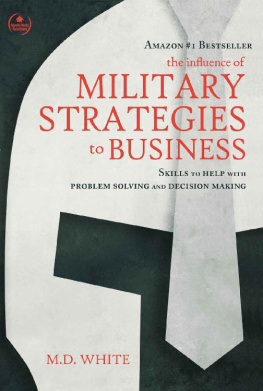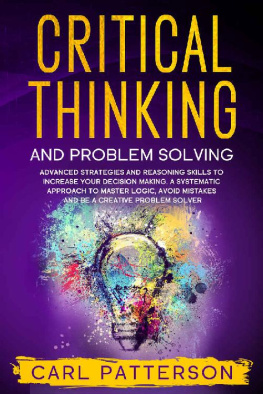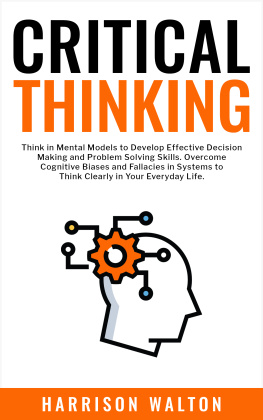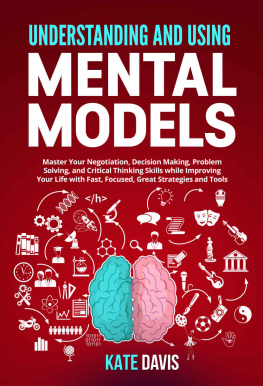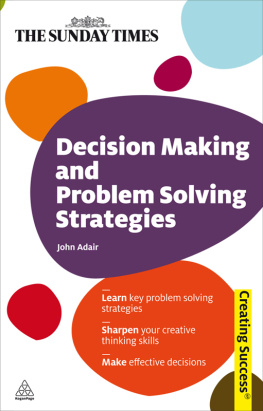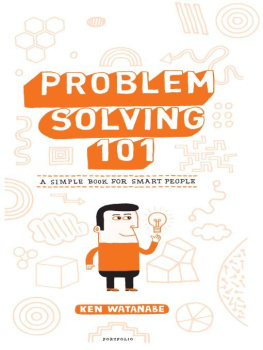MD White - The Influence of Military Strategies to Business: Skills to Help With Problem Solving and Decision Making
Here you can read online MD White - The Influence of Military Strategies to Business: Skills to Help With Problem Solving and Decision Making full text of the book (entire story) in english for free. Download pdf and epub, get meaning, cover and reviews about this ebook. year: 2017, publisher: Hopeful Media Solutions, LLC., genre: Business. Description of the work, (preface) as well as reviews are available. Best literature library LitArk.com created for fans of good reading and offers a wide selection of genres:
Romance novel
Science fiction
Adventure
Detective
Science
History
Home and family
Prose
Art
Politics
Computer
Non-fiction
Religion
Business
Children
Humor
Choose a favorite category and find really read worthwhile books. Enjoy immersion in the world of imagination, feel the emotions of the characters or learn something new for yourself, make an fascinating discovery.
The Influence of Military Strategies to Business: Skills to Help With Problem Solving and Decision Making: summary, description and annotation
We offer to read an annotation, description, summary or preface (depends on what the author of the book "The Influence of Military Strategies to Business: Skills to Help With Problem Solving and Decision Making" wrote himself). If you haven't found the necessary information about the book — write in the comments, we will try to find it.
MD White: author's other books
Who wrote The Influence of Military Strategies to Business: Skills to Help With Problem Solving and Decision Making? Find out the surname, the name of the author of the book and a list of all author's works by series.
The Influence of Military Strategies to Business: Skills to Help With Problem Solving and Decision Making — read online for free the complete book (whole text) full work
Below is the text of the book, divided by pages. System saving the place of the last page read, allows you to conveniently read the book "The Influence of Military Strategies to Business: Skills to Help With Problem Solving and Decision Making" online for free, without having to search again every time where you left off. Put a bookmark, and you can go to the page where you finished reading at any time.
Font size:
Interval:
Bookmark:
THE INFLUENCE OF MILITARY STRATEGIES TO BUSINESS
Skills to help with problem solving and decision making
M.D WHITE
Copyright 2017 by M.D. White.
All rights reserved. This book or any portion thereof may not be reproduced or used in any manner whatsoever without the express written permission of the publisher except for the use of brief quotations in a book review.
Cover design by Katie Norton
Layout and interior design by All Stories Editing
Printed in the United States of America
First Printing, 2017
Second Printing 2018
HOPEFUL MEDIA SOLUTIONS LLC
845 East Highway 88, Suite 247 Jackson, CA. 95642 www.HopefulMediaSolutions.com
ISBN-10: 1-947920-03-0
ISBN-13: 978-1-947920-03-3
Dedicated to my greatest achievement, my most prized possession
MONTE
INTRODUCTION
T he parallels between war and business planning are numerous. The important distinctions between war and business planning involve the ultimate ends of a given conflict. War involves physical destruction and death. When a business conducts operations, economic utility is generated, and employees, stakeholders, and society on the whole derive some benefit. The nature of competition is generally regulated by law, and if disputes arise among rivals, either marketplace conditions or legal systems will make a binding decision over corporate life and death, victory or defeat. Introducing the analogies of war into the business environment is complex and may arouse emotions and an ethos contrary to the culture of commerce. As multinational businesses expand their reach, they can be engines of wealth generation and peace. However, if global corporations adopt an overly martial ideology, then the hopes for human progress and cultural evolution will be dashed.
WAR PLANNING
T he fundamental objective of a war plan is the imposition of the victors terms on the opponent, which could also be defined as total victory. Military historians can cite exclusions to this definition, however, the purpose of this book is not centered on arcane military history debates. With few exceptions, modern military conflict results in the deaths of the combatants armed forces and civilians, and the physical destruction of property and economic assets. Additionally, war plans are usually carefully planned before a conflict but are rarely executed exactly as projected during the engagement. The arrangements are generally redeveloped in lieu of alterations during a war.
An example of grand strategy conflict was the Pacific campaign waged between Japan and America from 1941 to1945. Prior to engaging America and Great Britain in 1941, the Japanese created a detailed stratagem. It was designed to suddenly destroy the offensive capabilities of both the Americans (the Pacific fleet at Pearl Harbor) and the British (key military bases in Singapore and Hong Kong), the rapid seizure of economic resources and territories in Southeast Asia (present-day Malaysia and Indonesia) and the Western Pacific (the Philippines, Guam, Wake and Midway Islands). The Japanese planned to achieve these objectives within six months of the start of hostilities. The ultimate goal of the Japanese was to rampage in Southeast Asia and the Pacific, then propose a peace settlement with a demoralized America and Britain to gain international recognition of the Empire of Japan as a superpower.
America had anticipated war with Japan since the late 1800s and crafted and periodically revised many offensive strategies culminating in War Plan Orange. It served as the United States Pacific war plan until the defeat of Japan in September 1945. Plan Orange called for a decisive naval engagement with the Japanese off the coast of the Philippines, then a naval blockade of the Japanese home islands to force Japans surrender. Events (successful air and naval campaigns) and new technology (the submarine, aircraft carrier, and atomic bomb) and other tactical considerations altered Plan Orange, however its strategic goal of imposing Americas will on Japan was achieved.
Many military historians and contemporary business students view the Chinese military strategist, Sun Tzu (ca.500 B.C.E.) as the developer of the Bible of strategy . Wong, Maher, and Lee (1998) confirmed that Sun Tzus principles are divided into basically two components:
Knowing oneself
Knowing the enemy
Although Sun Tzu recommended that war be avoided if at all possible, he provided warriors with the principles of strategy if war erupted. Many of Tzus teachings have laid the foundation for today's theory of strategic management. Sun Tzu's strategy consisted of five elements:
Tao
Weather
Terrain
Leadership
Systems
These elements are presently thought of in terms of external and internal environmental analysis in present-day strategic management. Sun Tzu believed that close management and monitoring of the five factors would build a strong organization.
Sun Tzus five elements constitute the basic components that comprise any war plan. The fundamentals of war planning which includes an assessment of ones capabilities and gathering intelligence on the enemy to determine their strengths, weaknesses, capabilities, and intentions. However, the most important goal of any war plan is victory over the adversary. War involves deploying as many factors necessary to achieve triumph, including the sacrifice of human lives and consuming as many physical (oil, metals, food) and economic (production plans, currency controls, etc.) assets as required to accomplish the objective.
Finally, war involves great risk. One side, such as Japan, can initiate a conflict to achieve results. However, if the instigator is unsuccessful, it may lose control over its destiny and physical territory and be subject to physical occupation by the victor.
This book focuses on and is filled with tracts touting the adaptations of military strategy and other analogies to guide businesses. Most researchers, for example, point out how the military doctrine of C3I (command, control, communication, and information) which should be the basis for corporations to manage crises. The author studied three contamination cases faced by Perrier, Vita Soy, and Coca-Cola, as examples of how large corporations used C3I to effectively deal with a clear and present danger. Most researchers have enthusiastically embraced the corporate use of military doctrine.
Reflecting the spirit of the times, they have promoted the exploration of a deterrence strategy because if properly devised and executed, deterrent strategies offer the highest return and help to preserve intact the companys security, sovereignty, and power. The researchers entire presentation is laced with Cold War terminology.
They sound like a Presidents national security advisor when they proclaim that the four key elements of a successful corporate deterrence strategy are:
Credibility
Capability
Communication
Rationality
After reading the above, one can almost imagine a McDonalds executive putting all of its stores on red alert status and scrambling its franchises to be prepared to launch a preemptive soft serve ice cream sale on Wendys.
Some other researchers take lessons from a classic Indian epic the Bhagavad Gita, to derive management strategies. The Bhagavad Gita stresses self-control focusing on discipline in perseverance, detachment from fruits of labor, and devotion to duty. The key components in business management are the 5Cs:
Capital
Capability
Connections
Communication
Commitment
While the analogies between war and business planning may feel superficial and appear transferable, some researchers argue against not only the overt comparisons but describe the subtle damage that a military lexicon may have on businesses. The research shows that post-industrial business is less rigid and command-control oriented, requiring less hierarchical structures and more independence, creative employees.
Next pageFont size:
Interval:
Bookmark:
Similar books «The Influence of Military Strategies to Business: Skills to Help With Problem Solving and Decision Making»
Look at similar books to The Influence of Military Strategies to Business: Skills to Help With Problem Solving and Decision Making. We have selected literature similar in name and meaning in the hope of providing readers with more options to find new, interesting, not yet read works.
Discussion, reviews of the book The Influence of Military Strategies to Business: Skills to Help With Problem Solving and Decision Making and just readers' own opinions. Leave your comments, write what you think about the work, its meaning or the main characters. Specify what exactly you liked and what you didn't like, and why you think so.

